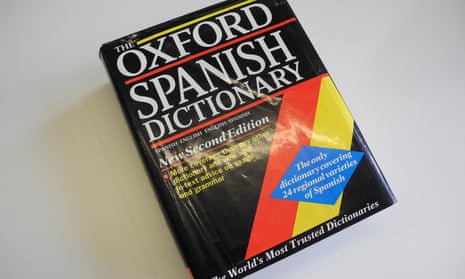The news was striking and, to some, alarming: the United States is now the world’s second largest Spanish-speaking country after Mexico. It has 41 million native Spanish speakers and 11.6 million who are bilingual – more than Colombia or Spain – and is on course to be the biggest Spanish-speaking nation on Earth, with Spanish the mother tongue of almost a third of its citizens.
The study, published this week by Spain’s Instituto Cervantes, made global headlines and dismayed those in the US who fear linguistic pollution. “I thought we spoke ENGLISH here,” tweeted Scott Rogers, a Florida-based conservative blogger.
Coming on the heels of the Spanish-language network Univision dumping Donald Trump’s Miss USA pageant over his disparaging remarks about Mexican immigrants, it underlined a sense of surging Hispanic power.
Reality turns out to be a bit more complicado. Spanish is not becoming an all-conquering cultural force. It is not turning swaths of the US into Spanish-only realms. It may, in fact, eventually shrivel.
“Spanish dominance, it’s not going to happen. English will obviously be the dominant language,” said William Frey, a demographer at the Brookings Institute and author of Diversity Explosion: How New Racial Demographics Are Remaking America.
Otto Santa Ana, a professor at UCLA who edited the anthology Tongue-tied: The Lives of Multilingual Children in Public Education, agreed. “All the fears that people have that the [primary] language will not be English are unfounded.”
With the Latino population expected to grow from 17.4% of the US population to 30% by 2060, Spanish will inevitably grow, but the enthusiasm second- and third-generation Latinos have for English will act as a brake. So too will the fall in the number of immigrants from Latin America.
Those trends, combined with social and economic currents which both weaken and strengthen Spanish in the US, suggest a future of waxing and then possibly waning influence.
A century ago, millions in the US spoke German, alarming those who considered it a threat to English. A halt to immigration from Europe plus two world wars all but wiped it out.
Barring catastrophic events, Spanish will not disappear, says Roberto Suro, a Latino affairs scholar at the University of Southern California. But competing factors will determine its rise or fall.
More than three-quarters of third-generation Latinos are “English dominant”, meaning they prefer it to Spanish, which they seldom speak, if at all, said Mark Lopez, director of Hispanic research at the Pew Research Center. More than 80% of Latinos feel they need to learn English to succeed in the US.
More than a quarter of Latinos marry non-Latinos, and more than a quarter of Latino babies have a non-Latino parent. “The Hispanic community is changing. We’re at the beginning of this story,” said Lopez.
About a third (34%) of Hispanic people will speak only English at home by 2020, up from 25% in 2010, according to a 2011 paper by census demographers Jennifer Ortman and Hyon Shin.
Assimilation atrophied Polish, Italian, German and other languages which once reverberated around US cities. Spanish, however, has a replenishing supply of immigrants.
Last year’s net intake was 305,000 – much reduced from two decades ago but still a significant number, especially given the sluggish economy and high number of deportations, said Suro. “This continuous flow of new arrivals will help keep Spanish alive. Hispanic migration patterns have proved durable.” Should the US economy gain steam, the number attempting to enter, legally or illegally, is expected to jump.
The highest concentration of Spanish speakers is in former Mexican territories – New Mexico (47%), California and Texas (both 38%) and Arizona (30%). Frey, the demographer, said such states would resemble a bilingual melting pot compared to Quebec, Canada’s French-speaking province. “It’s a generational dynamic. They need English for jobs and interracial relationships.”
Resentment at perceived Hispanic ascendance is a staple at Tea Party rallies which play Press One for English, a country song by Kay and Ron Rivoli which scolds non-English speakers (“Folks when you reach our shores you should speak our language not the one you spoke before”). Radical blogs warn about a Hispanic “conquest”.
Proliferating media outlets reduce the pressure to learn English by offering bountiful Spanish content, including commentary on all-American events such as the Super Bowl. Some 95% of Latinos say it’s important for Latinos in the US to be able to speak Spanish, a sign of pride in their heritage.
But bilingual Latino millennials prefer Fusion’s English fare to Univision’s Spanish programmes. The Guardian recently interviewed US Latinos trying – and in some cases struggling – to learn Spanish as adults.
Their efforts underline the fact that the US breeds English. Santa Ana, the UCLA academic, has offered a top grade to any student who can find someone who grew up here and does not speak native English. “No one’s gotten an A in 20 years.”
Growing up speaking little or no Spanish was not fixed by later expressing pride in Latino heritage, he said. “By that time the damage is done.”

Comments (…)
Sign in or create your Guardian account to join the discussion